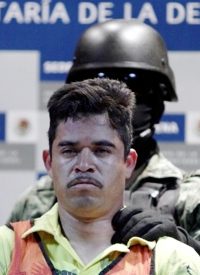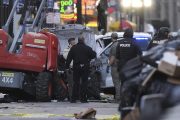
A single high-powered 7.62 mm gun purchased in north Texas is connected to the fatal shooting of Immigrations and Customs Enforcement (ICE) agent Jaime Zapata last month in northern Mexico, as reported by WFAA.com in Dallas/Fort Worth on Monday.
On February 15, ICE agent Jaime Zapata was killed and his fellow agent Victor Avila wounded when at least two vehicles of gunmen ran the agents’ Suburban off a Mexican federal highway and opened fire.
The military style handgun was recovered at the scene, but the serial number had been filed off. Once the number was restored through a relatively new technology called “raising,” officials were able to trace the weapon, announcing Monday that it had been purchased by a drug trafficking ring in the city of Lancaster, a suburb just south of Dallas.
Bureau of Alcohol, Tobacco, Firearms and Explosives (still known as BATF) agents made a positive identification leading them first to a gun shop in Joshua, Texas (south of Fort Worth), whose owner had legally sold the gun and done all required background checks. From there it was traced to a Lancaster residence.
On Monday authorities stormed the Lancaster home, arresting brothers Otilio and Ranferi Osorio. They also took into custody the next-door neighbor, Kelvin Morrison. According to federal officials, the three have been under investigation since last year for smuggling. They had sold 40 weapons to a federal informant, but had not been arrested.
Robert Champion, special agent in charge of the BATF field office in Dallas, explained:
We believe they [drug cartels] have their own firearms trafficking organizations, individuals here to purchase guns for these organizations. This is a typical firearms trafficking scheme that we have been investigating for quite some time.
Federal officials have been tracking rings who work for Mexican drug cartels operating unfettered in northern Mexico, just across the Rio Grande River (the international border). Tom Crowley, BATF spokesman for the Dallas division, stated, "Texas is a major source state for weapons going to Mexico — it is the size of our border and the amount of [firearms dealers]."
Chron.com reports that the investigation in Mexico of Zapata’s death has bagged a dozen drug cartel suspects, and is moving very quickly compared to other Mexican investigations. But the tracing of the gun to arms trafficking rings is not new to Texas authorities. The BATF claims Americans are being recruited by Mexican drug cartels to purchase the guns used in the lethal turf wars, offering $50 to $500 per weapon. Agent Crowley added:
You aren’t going to come all the way to Dallas and buy two or three weapons to smuggle them. You come up here, you are going buy more — they’ve got the money.
Though reports of arrests and new information in the Zapata killing are surfacing daily, much of it remains confusing. For instance, it is still unclear exactly who opened fire on the agents’ vehicle on February 15.
Early last Sunday, Mexican marines raided a Saltillo hotel and arrested alleged Zetas captain Sergio Mora Cortes. Saltillo, a Mexican city about three hours south of the Texas border city of Laredo, lies in the region of much of the country’s horrific cartel-related violence. Mora reportedly directed Zetas operations in the state of San Luis Potosi, where agent Zapata was killed. However, just last week another Zeta criminal, Jesús Rejon, was topping the list of suspects in Zapata’s murder.
When known drug criminal Julian Espinoza, known as “El Piolin” or Tweety Bird, was arrested last week, he stated that the hit on the two ICE agents was a mistake.
Texas District 10 Representative Michael McCaul, chairman of the House Homeland Security Oversight and Investigations Committee, voiced the sentiments of most Texans, as reported by NPR on Feb. 17. He reported that the two ICE agents, on temporary assignment in Mexico, had identified themselves to their attackers as U.S. diplomats, "hoping they [the Zetas] would honor the long-standing tradition that they don’t [target] U.S. law enforcement … This was a complete ambush. This is a complete game changer. They are changing the rules."
McCaul noted that while the motive for the attack remains unclear, one thing is certain:
There’s no case of mistaken identity. My sense is that we know, we probably have pretty good intelligence as to who was behind this. That’s what it appears to be.
McCaul also indicated that he plans to schedule congressional hearings to examine the U.S. role in Mexico’s ongoing drug war, which has killed more than 36,000 people since Mexican President Felipe Calderón took office in December 2006.
No details have yet surfaced resolving the roles of these cartel members and exactly who did what in the Zapata ambush.
In spite of confusion, though, American officials are pushing back. As a result of Zapata’s death, a massive U.S. sweep of drug gang suspects has resulted in hundreds of arrests and seizures of drugs, money, grenades, and other weapons. And federal authorities are sending a message to the cartels. Special Agent in charge of the Drug Enforcement Administration’s (DEA) special operations division Derek Maltz, declared that cartel members should never "sleep easy": "Look to your left, look to your right, look behind you. If you are sleeping in your bed, you better be aware that we are tracking you."
Many Americans remember the last murder in Mexico of a U.S. agent, Enrique (“Kiki”) Camarena, 26 years ago. After Camarena’s death, the border was essentially shut down. DEA agent Carl Pike noted that the border shutdown in 1985 sent a compelling message to the cartels, but that the younger cartel criminals today don’t remember that.
Many Americans, especially those in border states, are calling for another, long overdue shutdown.
Photo: A soldier escorts Julian Zapata Espinosa, aka "El Piolin", alleged member of the Los Zetas drug cartel and main suspect in the killing of U.S. Immigration and Customs, ICE, agent Jaime Zapata, in Mexico City, Feb. 23, 2011: AP Images



